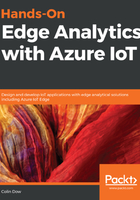
The standard IoT solution
The following diagram shows the standard IoT solution that you would take for your high-tech vending machines:

As you can see from the preceding diagram, each vending machine sends sensory information to the cloud, where an IoT dashboard arranges it in a clean interface. You are able to view your IoT dashboard on any device you choose, whether that be a PC, tablet, or cell phone.
Business is going really well. You can't keep up with demand. You are rolling out new vending machines as fast as you can. As a result, your dashboard is constantly having to keep up with more and more data coming in. Your IoT software vendor can't keep up with the increasing demand on its systems. Your sensory data is competing with the data coming in from the vendor's other customers. Your dashboard is no longer accurate. This is due to the inherent flaws of using the cloud to process simple telemetry data. It simply takes too long and is too inefficient to send sensory data up to the cloud. As well, your cellular data costs are too high, as each vending machine is constantly sending sensory data to the cloud even if the data has not changed.
How can you improve your architecture? Using an edge analytics approach could be the answer to these issues.